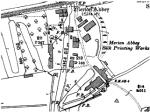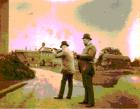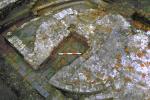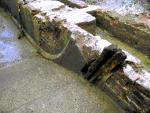
The Merton Abbey works [Full image 39kb]
During 12 weeks between September and December 2002 the Museum of London Archaeology Service (MoLAS) was funded by Countryside Properties Plc to undertake an archaeological excavation of Bennett's mill prior to redevelopment.
Bennett's mill dates to 1802 and was established for the production of cotton handkerchiefs and other fine goods. It formed part of the much larger calico printing works known as the "Merton Abbey Print Works" founded on this site in 1724.
In 1802 a calico printer called John Leach established a new works on the site for his improved method of madder dyeing. This method included boiling the madder root instead of using cold water. This had the advantage of extracting more dye. About 1811 the works were in the hands of Thomas Bennett, Leach's son-in- law.
 |
The Merton Abbey works [Full image 39kb] |
The Merton Abbey works, as they had now become known, were taken over by Edmund Littler in 1831 for the production of silks and fine fabrics. Two years later Littler also acquired Bennett's print works and the site became one large printing manufactory.
Map of 1894 showing the Merton Abbey Print Works. The two buildings in the southern part of the works are "Bennett's mill". To the north of Bennett's mill is the mill pond which supplied the water wheel within the middle of the building
 |
Bennett's mill in the 1890s. The man with the gun is Edmund Littler, the owner of the printing works (Courtesy of Merton Library Service) [Full size image 30.4kb] |
In the 1870s Liberty's became the most fashionable place to shop in London and the fabrics were used for both clothing and furnishings. The demand Liberty created soon began to outstrip sources of supply and he decided to import ready woven fabric and dye or print it in the UK. He achieved this by using the expertise of two printing companies - Thomas Wardle of Leek in Staffordshire (also used by William Morris) and Edmund Littler of Merton Abbey in Surrey. By the 1890's, Littler's were producing all of Liberty's goods. The hand block printed quality that Littler used became synonymous with "Liberty Art Fabrics". In 1881 William Morris, a competitor of Liberty, acquired a printworks downstream from Liberty on the River Wandle. Liberty is believed to have said "we send our dirty water downstream to Morris". Liberty purchased the Merton printworks in 1904.
Shortly after Liberty's acquired the site a number of the earlier weather-boarded buildings, including Bennett's mill, were demolished. The eastern range of brick buildings were adapted to suit Liberty's needs.
 |
One of the brick dye furnaces. The scale is 0.5m [Full image 56kb] |
Liberty and Co. ceased production at the Merton Abbey Works in 1972, but textile production continued at Merton with Vita-Tex Ltd, Riseline Ltd and finally Merton Fabrics Ltd. The premises finally closed in 1982. The archaeological excavation of Bennett's mill has revealed the entire range of workshops including the water wheel head-race and tail-race which ran through the middle of the building. Within the western part of the trench are four brick furnaces used for the production of dyes. These furnaces were fueled with coal and recovered from the coal ash were fragments of madder, indigo and woad dyes. A dye mixing paddle and a copper strip from a print block were also found.
To the east of the water wheel race was the wash room for the washing of excess dye from the calico. Here, excavations have revealed a brick wash tank and a number of drains to expel the excess water. A number of brick machine bases were also revealed which may have housed a mechanical washing machine.
 |
The waterwheel pit and sluice gate bracket of the waterwheel within Bennet's mill [Full image 44.3kb] |
Further east again are three furnaces and to the south is a cellar containing another three furnaces, Recovered from the cellar was a leather apron and a large number of bottle stoppers suggesting dye mixing was carried out here.
Within the eastern part of the excavation are a number of brick walls to a series of buildings. The presence of a number of iron pipes and large deposits of coal suggests that these buildings once held the steam engine known to have been located on the site since 1802.
Recovered from a number of deposits within Bennett's mill were a number of 19th century coins, Liberty's cloth seals, a Liberty's plastic dye bucket, pottery and iron work from a number of machines and furnaces.
David Saxby
Museum of London Archaeology Service
Ó Museum of London
Mortimer Wheeler House,
46 Eagle Wharf Road,
London N1 7ED
tel 0207 410 2244
fax 0207 410 2201
email molas@molas.org.uk
|
|
|
|